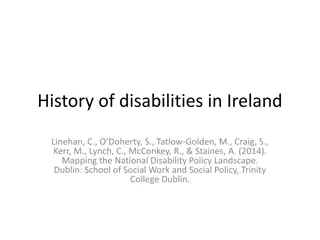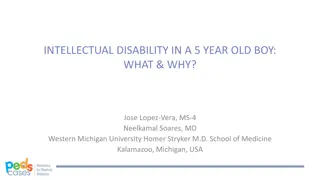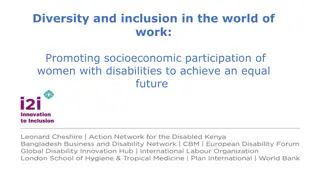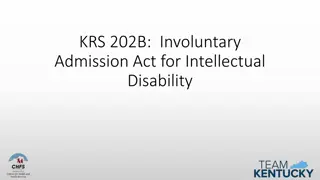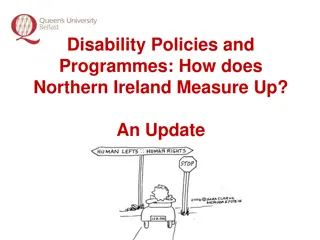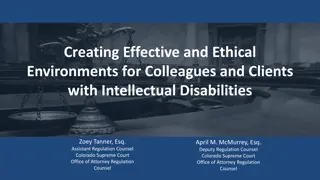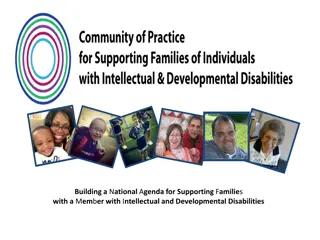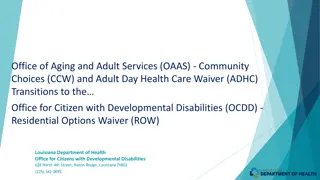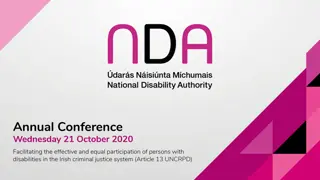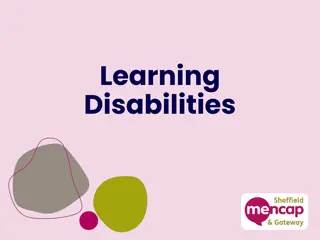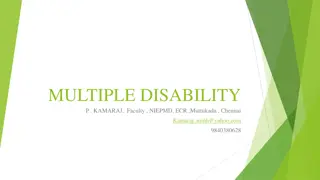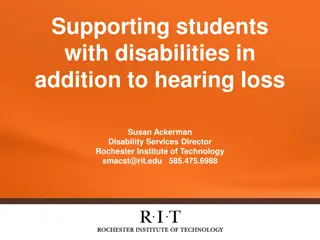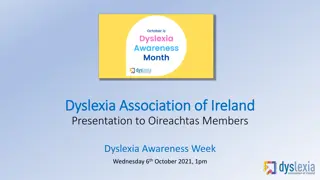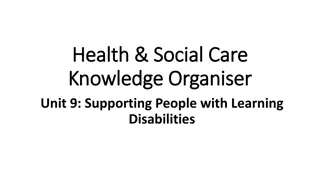Evolution of Service Delivery Models for Intellectual Disabilities in Ireland
Residential services for individuals with intellectual disabilities in Ireland have evolved over the years, transitioning from congregated settings to group homes and independent arrangements. This shift has seen a decrease in residents in congregated settings with a rise in those living in group homes or independently, offering more choice and autonomy to individuals. Different types of accommodation are now available, reflecting a move towards community integration and person-centered care.
Download Presentation

Please find below an Image/Link to download the presentation.
The content on the website is provided AS IS for your information and personal use only. It may not be sold, licensed, or shared on other websites without obtaining consent from the author. Download presentation by click this link. If you encounter any issues during the download, it is possible that the publisher has removed the file from their server.
E N D
Presentation Transcript
Models of service delivery in Ireland
Residential services Although most children and many adults with intellectual disabilities live with their families, there has been a long tradition in Ireland of providing residential accommodation either by voluntary organisations, religious congregations or in psychiatric hospitals. Today, adult persons with intellectual disability may live away from their families in three broad types of accommodation:
Congregated settings: This is mostly campus accommodation of separate bungalows and houses on a shared site (HSE, 2011). Though there is still a cohort of people under 65 living in nursing home accommodation more suited for older residents Residents have little choice over whom they live with; they share communal bathing facilities, dining and sitting rooms, though some had their own bedroom Staff are available 24 hours a day although different staff might work across the various housing units and wards
Group homes: These are ordinary housing in the community shared by up to six persons with support staff available during day-time hours or on a 24 hour (sleep-in) basis. However these residents typically had a limited choice of co-residents although they will have their own bedroom
Independent arrangements: Typically these arrangements take the form of rented accommodation in ordinary houses or apartments with people either living alone or with a friend of their choosing. Most had support staff visiting their home at agreed days and times for a set number of hours per week in accordance with their needs.
How it looked in 2009 2009 group homes congregated independent 11% 43% 46%
How it looked in 2014 2014 congregated 40% group homes 47% independent 13%
The decrease in numbers of people living in congregated settings has been ongoing over the past decade and more. 2004 was the first year when the numbers of people living in group homes or independently exceeded those living in congregated settings (Barron and Mulvany, 2004)
The data shows a continuing reliance within Ireland on group homes as the main form of residential accommodation for adults with intellectual disability. Internationally the trend is towards more personalised forms of accommodation which tend to provide better outcomes for individuals and seem to be more cost- effective (Larson et al., 2013: McConkey et al., 2016). In Ireland certain CHO areas seem to have espoused personalised provision more so than other areas.
Waiting for vacancies to arise in existing provision as happens at present, will not prove sufficient to meet demand. Rather proactive planning is urgently required that involves reconfigurations of existing resources as well as estimations of increased funding.
DAY SERVICES The policy New Directions: Review of HSE Day Services and Implementation Plan 2012 2016 (2012) proposes a new approach to adult day services which envisages that all the supports available in communities will be mobilised so that people have the widest possible choices and options about how they live their lives and how they spend their time (p.3)
This review of day services was carried out to reconfigure and modernise HSE funded day services to embrace the principles of : personcenteredness, access, accountability and quality. The implementation of this policy will involve a shift from provider-led programmes to individualised, user- led supports which will enable people to live a life of their choosing that meets their own wishes, aspirations and needs (p.20).
TYPES OF DAY SERVICES Care centres: including activation centres, day programmes, specialist day services for older persons, higher support needs and intensive day services. Training schemes: including vocational training, rehabilitation training and attendance at third level education. Sheltered workshops: including long-term training schemes and sheltered employment centres. Employment: including supported employment and paid open employment on a part-time or fulltime basis.
People start to avail of day services after leaving school which is usually at 18 years of age for pupils with special educational needs. However some people aged 18 years and over were still in education or attending only an outreach programme such as community hubs from which attendees access community activities
2009 12% Training Training 12 % employment employment 53 % centres sheltered workshops care centres 23 % sheltered workshops
The percentage of places within the four types of day services in 2009 and 2014 2016 Training 11% employment 10% care centres 63% sheltered workshops 16%
nationally there was increase in day service places from 2009 to 2014: a net average of 180 extra places per year. During this time there was also a rebalancing in the type of places available with a 27% drop in places in sheltered workshops but a 24% increase in care centre places. The latter consisted mainly of places in Activation Centres (85% of the increase). There was also a small drop in people in paid employment (down 12%).
The national profile of Day Service provision changed over this period shows noticeable change is the increased proportion of people attending care centres (10% increase) a the drop in usage (7%) of sheltered workshops with a small drop in employment (2%) and training (1%) placements
Up to 90% of adult persons with an intellectual disability currently avail of a day service. Moreover the number of places available had increased in 2014 from 2009 despite the economic downturn between those years. most of the increase was in older people (55 years plus) attending care centres. The near universal coverage of day service provision for adult persons with intellectual disabilities most likely exceeds that of many other European countries although comparable data is not readily available.
Care centres are the dominant form of provision and in 2014 more people were using these services than in 2009 with a declining proportion of persons attending sheltered workshops and having paid employment over the five year period. The transfer of people from work related activities to care centres may have been a reaction to the criticisms of sheltered workshops and one which the HSE supported, although this change would not accord with the policy advice given by the NDA (2009)
The NDA recommended the conversion of sheltered work/day activity services to supported employment and integrated day services. Yet the numbers of people in employment fell from 2009 to 2014 and the proportion of those in open employment in 2014 was only 1.6% of all the adults recorded on the NIDD. Hence the lack of expansion in employment or training services suggests little progress in the implementation of New Directions for persons with intellectual disabilities.
new styles of day services such as outreach programmes are utilised by very small numbers of persons in 2014 (2% of all adults on database) although the numbers have increased from 2009. As non-centre based programmes characterise the model of provision recommended in New Directions, there is still some way to go in ensuring this model is more widely available. the continuing emphasis on the provision of care centre places into the future is concerning as it seems to indicate a lack of intention regarding the implementation of new support models as recommended in New Directions.
Respite breaks The provision of respite breaks was another form of support that intellectual disability services provide to family carers. These were initially offered in existing residential facilities although latterly special units were developed solely for short-stays. The length of stay could range from one or two nights through to seven days at a time. Families may be offered a number of such breaks in the course of a year. Different styles of breaks also started to emerge that better met the family s wishes and needs, as well as those of the person with intellectual disabilities
The number of children and adults living with family carers recorded on NIDD in 2009 and 2014 Age groups Children (Under 20 years) Adults (20 years and over) total 2009 8,816 2014 9,972 Difference 1,156 (13.1% increase) 7924 8,822 898 (11.3% increase) 16,740 18,794 2,054 (12.3% increase)
The proportion of people within each level of disability who received respite breaks in 2009 and 2014 80 70 60 50 40 30 2009 2014 20 10 0
People who have severe and profound disabilities aged 30 years and over are the most likely group to receive respite services. Over one third of family carers (37%) received respite services in 2009 but the percentage had dropped in 2014 to 32%, particularly for those receiving home-based support. This may reflect financial restrictions on services but the reduction came during a period when the number of persons living with families was increasing
Around 20% more people were deemed to require respite in the coming five years but were currently not receiving it. The demand was greater in some CHO areas than others, notably those that had the lowest proportion of people currently receiving respite break
It is clear from the data that services have largely maintained a stand still position and have not grown in accord with the increasing population of people with intellectual disabilities the evident demand for residential accommodation, day services and respite breaks. A further period of limited or no growth in service provision will only increase pressure on services and on family carers in particular. Hence in the coming years a planned development of services will be needed.
Reference Based on report published by Genio Ltd, Dublin, March 2017 https://www.researchgate.net/publication/329793317_Ch anges_in_the_Provision_of_Day_Services_in_Ireland_to_ Adult_Persons_With_Intellectual_Disability/citation/do wnload Mcconkey, Roy & Kelly, Fionnola & Craig, Sarah & Keogh, Fiona. (2018). Changes in the Provision of Day Services in Ireland to Adult Persons With Intellectual Disability. Journal of Policy and Practice in Intellectual Disabilities. 10.1111/jppi.12261.


